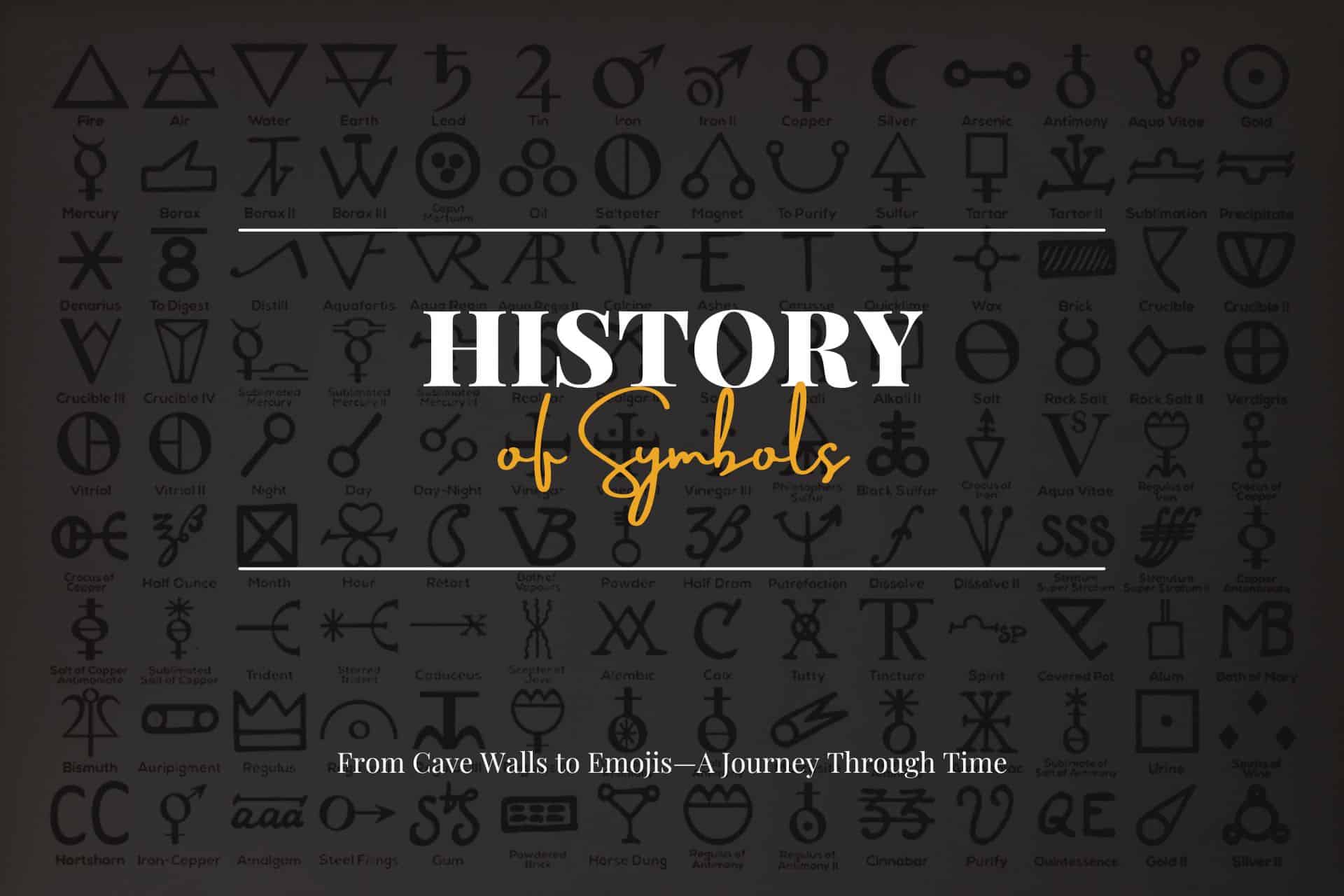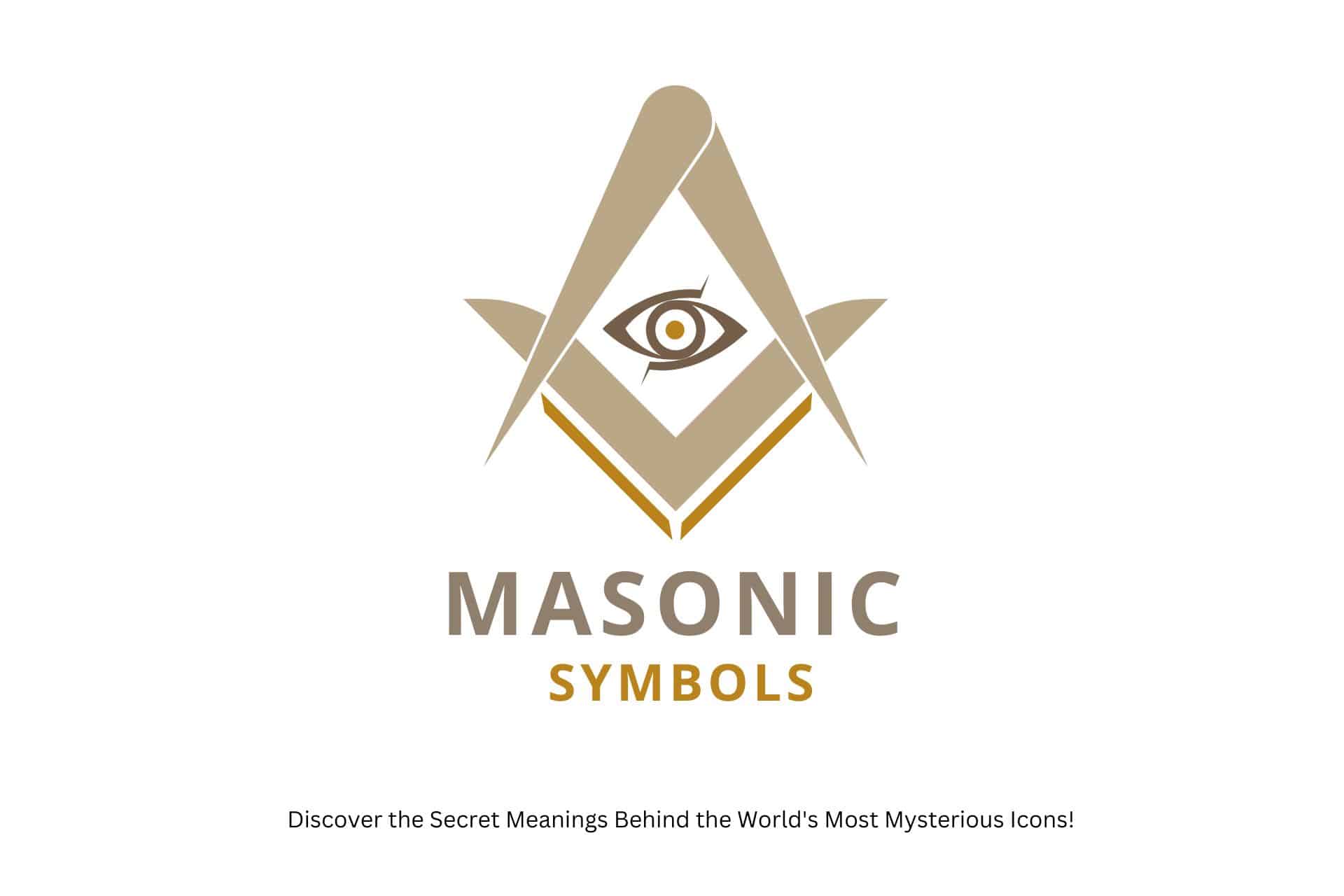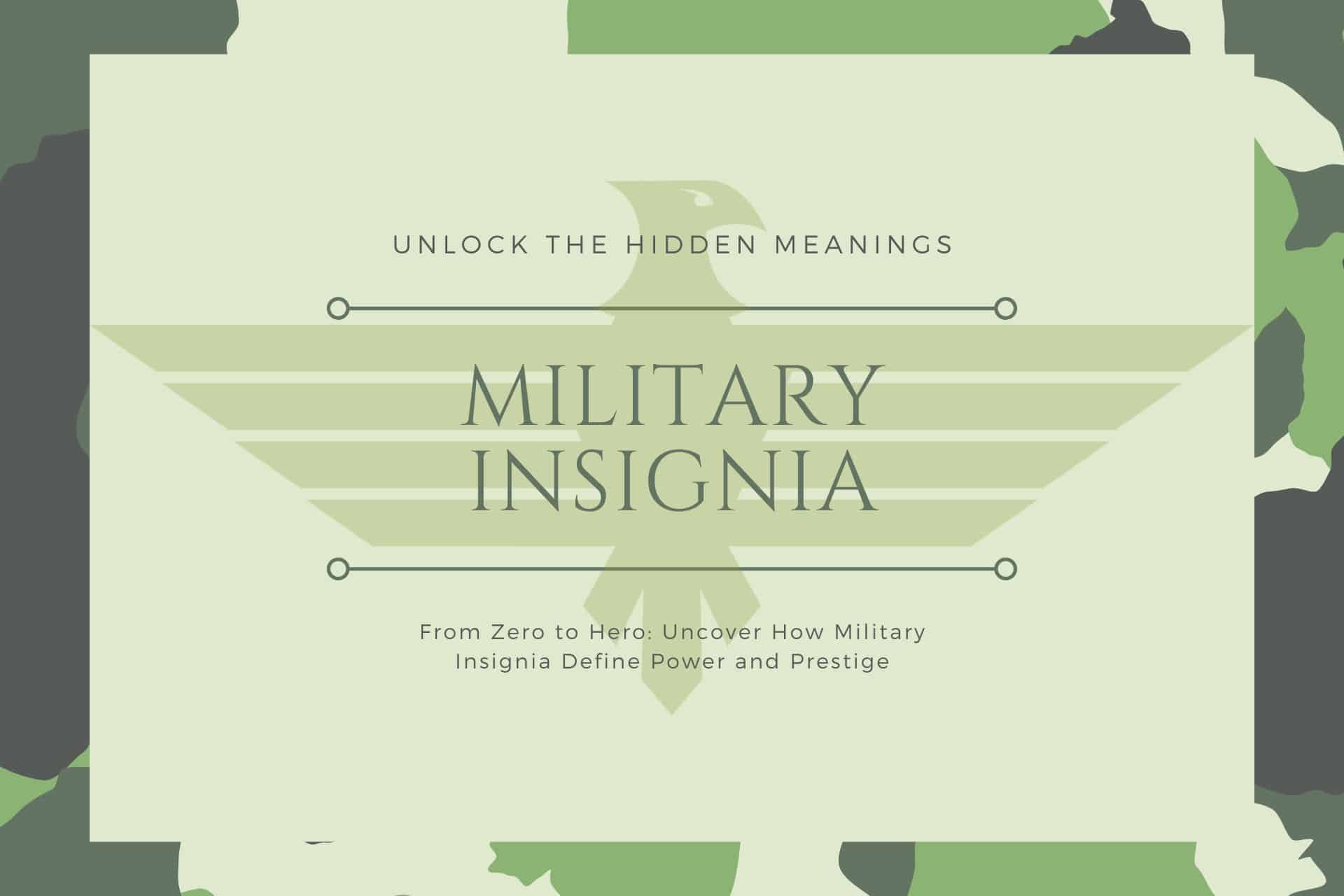Transform Your Messages From Emojis to Ancient Hieroglyphs
Are you intrigued by the world of communication symbols and eager to decode their meanings in our everyday lives?
Whether you’re fascinated by the simplicity of a traffic sign or the complexity of digital emojis, you’re not alone in pondering their origins and impact.
This article is your gateway to understanding the vast landscape of symbols facilitating human interaction across cultures and technologies.
Here, you’ll find an engaging exploration of their history, meaning, and how they continue to evolve with our societies.
Discover the power of communication symbols and how they shape our understanding and connection in a digitally interconnected world.
Continue reading to uncover the fascinating world of symbols that surround us.
Let’s get started!
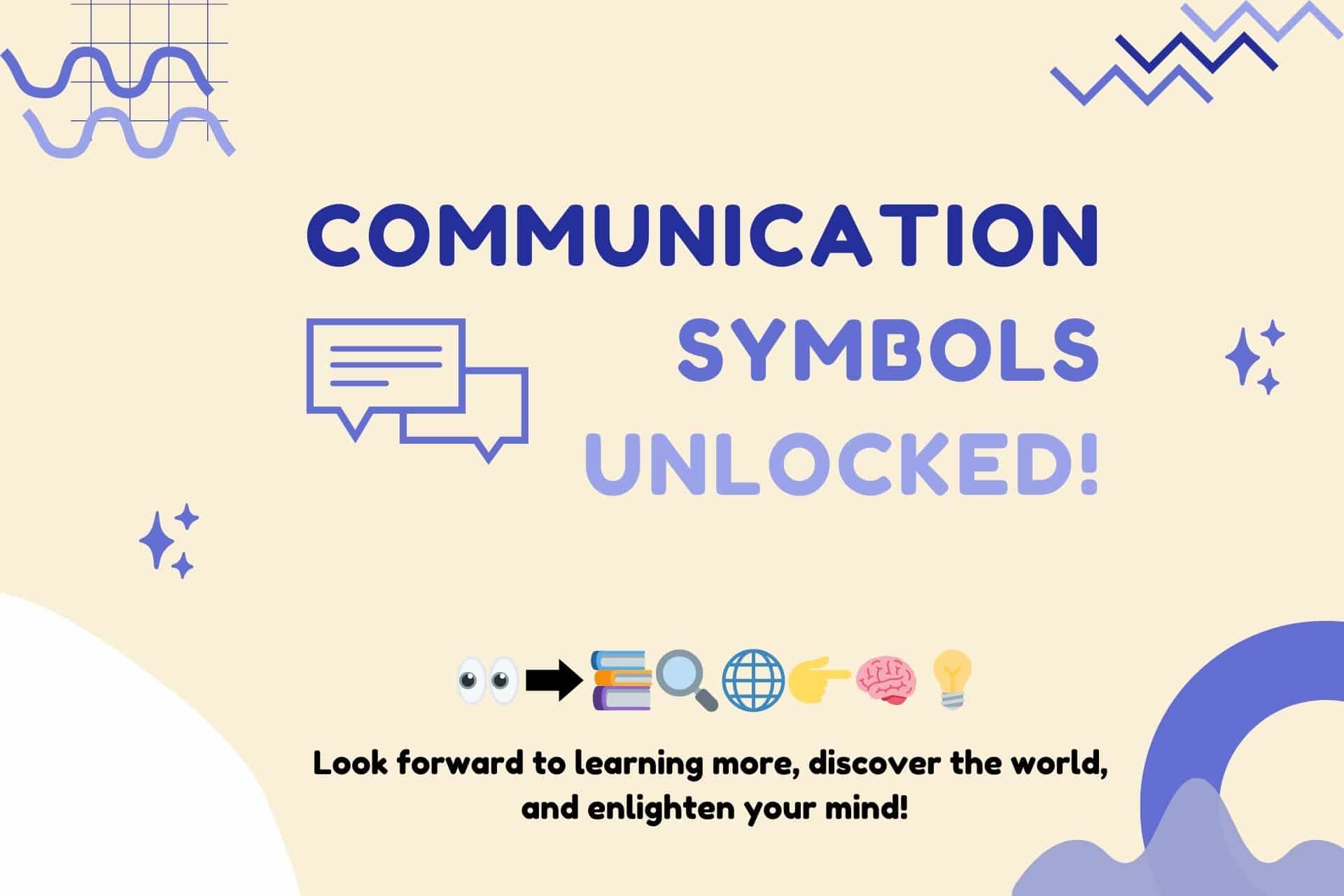
Here’s What You Will Find

Key Takeaways
Communication Symbols
Communication Symbols Span Beyond Words: Beyond spoken or written language, communication symbols encompass various signs, gestures, visuals, and digital icons, each serving unique purposes in conveying ideas, emotions, and intentions across diverse platforms and cultures.
Symbols Are Integral to Human Interaction: From ancient pictograms to modern emojis, communication symbols have evolved to facilitate understanding and connection, illustrating the ingenuity of human expression and the importance of symbols in bridging communication gaps.
Understanding Context is Key: The meaning of a communication symbol can vary significantly depending on its context, including cultural background, situation, and medium. Recognizing the nuances of different symbols is crucial for effective communication and understanding.
Digital and Global Influence on Symbols: The digital age has rapidly expanded our repertoire of symbols, with emojis and internet slang becoming central to contemporary communication. This evolution reflects the changing interaction landscape and the global blending of cultures and languages through technology.
What are Communication Symbols?
Communication symbols are varied forms of signs, icons, signals, gestures, and other representations used to convey information, ideas, emotions, and intentions without relying solely on verbal language.
Communication symbols are the cornerstone of our ability to express and interpret meanings beyond direct language.
At its core, a communication symbol carries a particular meaning recognized by people who share a culture. This can range from a simple thumbs-up gesture to the intricate emojis we sprinkle throughout our digital conversations.
The power of symbols lies in their ability to convey complex ideas, emotions, and actions using a shared understanding, making them indispensable in both personal interactions and the broader spectrum of societal communication.
These symbols can be broadly categorized into several types, each serving different purposes in facilitating understanding and interaction among people.
Types of Communication Symbols
The rich landscape of communication symbols is like unlocking a treasure trove of human expression and connectivity. This diverse expanse is not just a collection of arbitrary marks or sounds but a complex bridge system connecting minds and hearts across different mediums, cultures, and epochs.
From the whispers of ancient scripts to the loud buzz of digital notifications, communication symbols encompass many tools we use to convey information, emotions, and ideas.
We will explore the myriad symbols that serve as the backbone of our interactions, each playing a unique role in the art and science of communication.
Whether carved on stone, painted on canvas, or flashed on screens, these symbols collectively form the mosaic of human connection. They transcend language barriers and enhance our ability to share our innermost thoughts with the world.
The landscape of communication symbols is as vast as varied, encompassing the verbal and nonverbal cues we use daily.
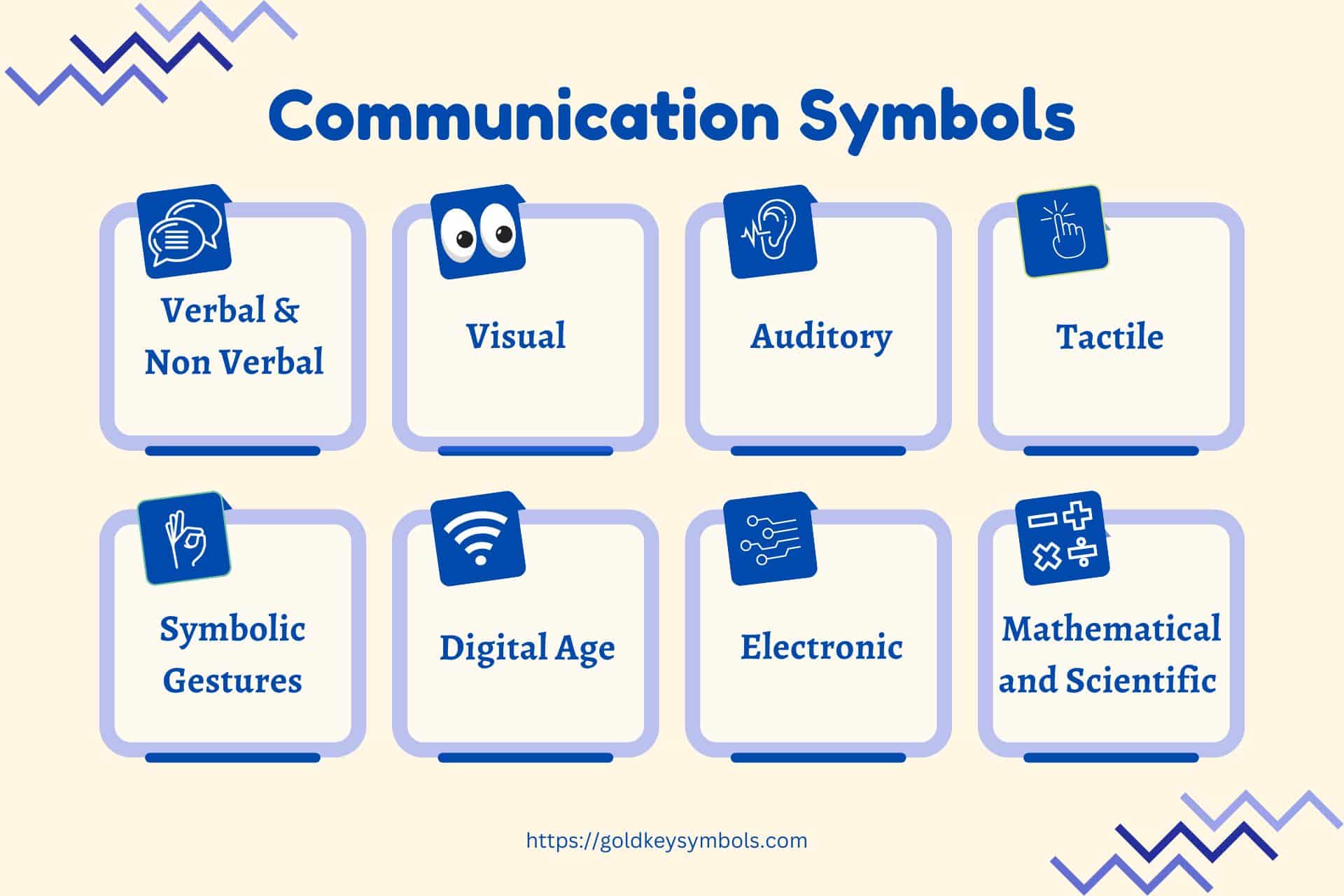
Here’s a closer look at the main types of communication symbols:
Verbal Symbols
- Language: The most direct form of communication involving spoken, written, or signed words. Each word functions as a symbol representing something else, such as an object, action, feeling, or idea.
Non-verbal Symbols
- Gestures: Physical movements of the body or limbs that communicate specific messages, such as a thumbs-up for approval or a shake of the head for disapproval.
- Facial Expressions: Non-verbal cues that convey emotions or reactions, such as a smile for happiness or a frown for discontent.
- Body Language: Body posture, stance, and movement can indicate attitudes, feelings, or relational stances between communicators.
- Sign Language: A structured language using hand gestures, facial expressions, and body postures to convey meaning, primarily used by the deaf and hard of hearing.
Visual Symbols in Communication
In the rich tapestry of our daily lives, we are constantly surrounded by various visual symbols, each crafted to communicate specific messages swiftly and efficiently.
From the straightforward pictograms that guide us through public spaces to the complex ideograms that distill abstract concepts into tangible forms, symbols play crucial roles in navigation, instruction, and identification.
Logos and icons enrich this visual vocabulary, acting as shorthand for brands and digital applications, weaving into our culture’s fabric.
Here’s a brief overview of these visual communicators:
- Pictograms: These are simple, universally recognizable images representing tangible objects or straightforward concepts. They are most often seen in public signs, helping to guide actions or provide warnings without the need for words.
- Example: The silhouette of a person walking indicates a pedestrian pathway.
- Ideograms: These symbols go a step further, representing more complex or abstract ideas through visual means. They require a level of cultural or contextual knowledge to be fully understood.
- Example: The peace symbol transcends language barriers to convey a universal message of harmony.
- Logos: Carefully designed symbols representing companies, brands, or products. Logos aim to encapsulate the essence of a brand in a visually memorable way, fostering instant recognition.
- Example: The apple with a bite taken out of it, representing Apple Inc., signifies innovation and simplicity.
- Icons: In digital contexts, icons represent functions, files, or programs. They serve as intuitive guides for users navigating software or websites, simplifying complex actions into clickable images.
- Example: A stylized envelope represents email applications or functions across various platforms.
Understanding these visual symbols and their applications enhances our ability to navigate the world around us, bridging gaps in language and literacy with the universal language of imagery.
Auditory Symbols in Communication
Auditory symbols stand out as powerful tools that transcend the need for visual cues, engaging directly with our sense of hearing. These symbols range from the structured language of music, with its notes and rhythms, to the instinctual response triggered by sirens or bells.
Each auditory symbol carries its unique message, capable of crossing barriers of time and space and evoking a wide range of emotional and physical responses. Here’s a closer look at the diversity of auditory symbols:
- Musical Notes: The building blocks of music, these symbols represent specific pitches and rhythms, enabling composers and musicians to record and reproduce complex musical pieces.
- Example: A series of notes on a staff communicates a melody that can inspire joy, sadness, tension, or relaxation, depending on its composition.
- Sirens and Alarms: These sounds are designed to grab attention and convey urgency. They are universally recognized signals that prompt immediate action or awareness.
- Example: the blaring of a fire alarm signifies danger and prompts evacuation, while an ambulance siren alerts traffic to make way for emergency services.
- Bells and Chimes: Often used to mark time or signify the beginning or end of an event, bells and chimes carry cultural and ceremonial significance in many societies.
- Example: The ringing of a school bell indicates the start or end of classes, while church bells can announce various social and religious gatherings.
Auditory symbols enrich our communicative landscape by providing an immediate, often visceral means of conveying messages.
Whether alerting us to danger or stirring deep emotional responses through music, these symbols play an essential role in human interaction and cultural expression.
Tactile Symbols in Communication
Tactile symbols offer a vital means of communication and navigation for individuals with visual impairments. They transcend visual and auditory barriers to provide information through the sense of touch.
Though not as widely recognized, these symbols foster independence and accessibility. Among the most notable tactile symbols are Braille and tactile paving, each serving distinct purposes in helping visually impaired individuals interact more effectively with the world around them.
- Braille: A tactile writing system consisting of raised dots arranged in specific patterns to represent letters, numbers, and punctuation marks. This system enables people who are blind or have low vision to read and write through touch.
- Example: Braille labels on everyday items, books, and public signs provide crucial information, allowing for greater autonomy in daily activities.
- Tactile Paving: These are textured ground surface indicators found in public spaces, designed to provide tactile feedback underfoot or via a cane. Tactile paving helps visually impaired individuals identify pedestrian crossings, platform edges, and footpath direction or elevation changes.
- Example: Raised domes at the edge of a train station platform warn of the drop-off, aiding in safe navigation.
By integrating tactile symbols into public infrastructures and daily utilities, societies can enhance accessibility and inclusivity, ensuring that individuals with visual impairments can navigate and communicate more freely and safely.
Symbolic Gestures and Rituals in Communication
In addition to tangible symbols, human communication is rich with symbolic gestures and rituals that convey meaning within specific cultural contexts.
These can range from ceremonial rites of passage to everyday actions, such as toasting with drinks. While not always involving a physical symbol, these actions are imbued with deep significance and communicate shared values and intentions.
Digital Age Symbols
The digital age has dramatically reshaped the communication landscape, ushering in a new era of symbols seamlessly integrated into everyday interactions.
Emojis and emoticons, for example, have revolutionized text-based conversations by offering a colorful and dynamic way to express emotions and nuances that words alone might miss.
On the other hand, internet slang and memes have emerged as powerful tools for capturing and disseminating complex ideas and cultural insights, all while fostering a sense of community and shared understanding.
Let’s explore this digital lexicon:
- Emojis and Emoticons: These graphical symbols range from simple smiley faces to an extensive array of images representing objects, actions, and emotions, enabling users to add emotional depth and clarity to digital messages.
- Example: A heart emoji can signify love, affection, or approval, enhancing a message’s emotional resonance.
- Internet Slang: Phrases and abbreviations unique to digital communication that convey messages quickly and efficiently. This slang evolves rapidly, reflecting the dynamic nature of online culture.
- Example: “LOL” (Laugh Out Loud) expresses amusement, while “BRB” (Be Right Back) signals a temporary departure from a conversation.
- Memes: These are images, videos, or texts that are copied and spread rapidly by internet users, often with slight variations. Memes can articulate shared experiences, humor, or social commentary in a way that resonates with a wide audience.
- Example: A popular meme image, like the “Success Kid” or “Distracted Boyfriend,” can be adapted to many situations and convey relatable feelings or reactions.
This digital lexicon continues to evolve, reflecting the changes in our society and the innovative ways we communicate and connect in the digital world.
Electronic Symbols in Communication
The electronic age has brought a specialized language of symbols essential for designing, understanding, and repairing electronic devices and circuits.
These symbols, a key feature of schematics and blueprints, serve as the shorthand for electrical components, allowing engineers, technicians, and hobbyists to interpret complex electronic systems quickly. Let’s break down some of these fundamental symbols:
- Resistors: Represented by a zigzag line, resistors limit the flow of electric current in a circuit. They are fundamental to controlling circuit conditions.
- Example: A resistor symbol in a circuit diagram indicates where current flow is intentionally reduced for various operational purposes.
- Capacitors: Illustrated as two parallel lines with a gap between them, capacitors store and release electrical energy in a circuit. They are crucial for filtering, buffering, and timing applications.
- Example: A capacitor symbol in a schematic points to where energy storage is used to smooth out electrical signals or provide temporary power.
- Transistors: Depicted with a combination of lines and arrows, transistors act as switches or amplifiers within circuits. They are pivotal in controlling the flow of electrical current.
- Example: A transistor symbol identifies points in a circuit where current is amplified or switched, enabling complex operations like signal modulation or digital computation.
These symbols form the backbone of electronic schematics, guiding the creation and maintenance of the myriad electronic devices that power our modern world.
Understanding these symbols is essential for designing, constructing, and troubleshooting electronic systems, making them a critical language for engineers and technicians.
Mathematical and Scientific Symbols
A rich tapestry of symbols underpins mathematics and the sciences, each meticulously designed to convey complex concepts with precision and brevity.
This specialized language allows for the universal communication of ideas, transcending linguistic barriers and enabling a shared understanding across the global scientific community.
From the foundational symbols of basic arithmetic to the intricate notations of advanced calculus, these symbols form the backbone of mathematical discourse.
Similarly, symbols ranging from chemical elements to units of measure are crucial in concisely expressing scientific principles and discoveries in the sciences. Here’s an overview of these essential symbols:
- Mathematical Symbols:
- Basic Operations: Symbols like “+,” “-,” “*,” and “/” denote addition, subtraction, multiplication, and division, respectively, and form the basic building blocks of arithmetic.
- Algebraic Notations: Letters and symbols represent variables and constants, allowing for the expression of equations and formulas.
- Calculus Symbols: Notations such as “∫” for integration and “d/dx” for differentiation enable the description of changes and motion.
- Scientific Symbols:
- Chemical Element Symbols: Each element in the periodic table is represented by a unique one or two-letter symbol, such as “H” for hydrogen or “O” for oxygen, facilitating the compact representation of chemical compounds.
- Units of Measure: Symbols like “m” for meters, “kg” for kilograms, and “s” for seconds standardize the quantification of physical quantities.
- Physics and Biology Notations: Symbols represent physical constants, variables, and biological terms, streamlining the communication of complex data and theories.
Through these symbols, mathematics and the sciences achieve clarity and efficiency that propels understanding and innovation. Whether scribbled on a chalkboard or published in a research paper, these symbols are the keystones of intellectual exchange in the quest for knowledge.
Bridging the Symbolic Divide
The diversity of communication symbols illustrates the ingenuity of human expression, enabling us to convey vast arrays of information, emotion, and culture.
Each type of symbol serves a unique purpose, catering to different senses and situations, from the urgency of an alarm to the nuanced expression of an emoji.
As we navigate the complex landscape of symbolic communication, it becomes clear that understanding these symbols—whether ancient pictograms or modern digital icons—is key to fostering connectivity and empathy in our increasingly interconnected world.
The Evolution of Communication Symbols
Tracing the evolution of communication symbols offers a fascinating glimpse into the human desire to connect and express. From the earliest cave paintings, which used simple images to record events and convey stories, to the hieroglyphs of ancient Egypt, symbols have always been a fundamental part of our communication toolkit.
As civilizations advanced, so did their writing systems, evolving from pictographic scripts to the alphabets that form the basis of many modern languages.
The advent of the printing press in the 15th century democratized information, made written symbols more accessible, and standardized their usage.
The 20th century saw another leap in symbolic communication with the rise of electronic media, which introduced new symbols for navigating the digital world. Today, the rapid pace of technological innovation continues to expand our symbolic vocabulary, transforming how we communicate in an increasingly connected world.
The Importance of Understanding Communication Symbols
Understanding communication symbols is akin to possessing a key that unlocks the myriad ways humans express thoughts, emotions, and intentions.
This knowledge enhances interpersonal communication, allowing for more nuanced and effective exchanges. It also bridges cultural and language gaps, fostering a deeper sense of empathy and connection among people from diverse backgrounds.
By deciphering the symbols we encounter in various contexts, we can navigate social interactions more smoothly, interpret media more critically, and appreciate the rich tapestry of human culture with greater depth.
Communication Symbols in Different Cultures
Communication symbols are as varied as the cultures that create and use them. They offer a window into different communities’ values, beliefs, and histories. While some symbols, like the heart for love, are nearly universally recognized, others are deeply rooted in specific cultural contexts.
For example, color symbolism can vary dramatically between cultures; while white is often associated with purity in Western cultures, it is traditionally linked to mourning in many Eastern cultures. Exploring the symbolic communication practices across the world highlights the diversity of human expression and the commonalities that link us across cultural divides.
Communication Symbols in Pop Culture
Pop culture serves as a dynamic canvas for creating and evolving communication symbols. Memes, hashtags, and viral trends are modern artifacts of symbolic communication, reflecting and shaping societal attitudes, humor, and values.
These symbols can transcend their original contexts to become part of a larger dialogue, influencing everything from fashion to political movements. Pop culture’s fluid nature means that these symbols’ life cycles can be brief, but their impact on collective consciousness is undeniable.
How to Interpret Communication Symbols
Interpreting communication symbols effectively demands a multifaceted approach, integrating context, cultural insight, and the unique subtleties inherent to each symbol.
These symbols, whether gestures, icons, or speech patterns, are the building blocks of our interactions. They encode complex messages into digestible signs.
However, their meanings are not fixed; they shift and evolve based on the scenario and the backgrounds of those engaging with them. This fluidity makes symbols incredibly powerful and occasionally challenging to navigate.
For example, consider the varied interpretations of nodding. In many Western cultures, a nod signifies agreement or affirmation, yet it can mean the exact opposite in parts of Greece, Turkey, and Iran.
Similarly, the thumbs-up gesture, widely recognized as a sign of approval in many countries, can be interpreted as a rude gesture in others. Such disparities underline the importance of cultural literacy in our interconnected world, where a message meant to convey friendliness could easily be misconstrued as disrespect due to a lack of understanding of these nuances.
To navigate the complex landscape of communication symbols, consider the following key points:
- Contextual Clues: The setting in which a symbol is used can greatly influence its meaning. A casual and friendly gesture in one context may be formal and serious in another.
- Cultural Background: Symbols are deeply rooted in cultural traditions and histories. What is considered a universal sign in one culture might have a completely different interpretation in another.
- Sender’s Intent: Understanding the perspective and intention of the person using the symbol is crucial. Misinterpretation can lead to confusion or offense.
- Situational Context: The specific circumstances surrounding the communication can alter the meaning of symbols. This includes the relationship between the individuals involved, the medium of communication, and any prior interactions.
One can become more adept at decoding the rich tapestry of symbols that facilitate human connection by paying attention to these aspects. This skill is particularly invaluable in today’s globalized society, where interactions often span across diverse cultural landscapes, making the ability to interpret symbols accurately a key component of effective communication.
FAQs About Communication Symbols
What are the most universally recognized communication symbols?
Some symbols, such as the heart, smiley face, and stop sign, are recognized across many cultures due to their simplicity and widespread use.
How do communication symbols differ across cultures?
Symbols can vary greatly in meaning and usage across cultures, reflecting language, tradition, and values differences. Understanding these differences is key to effective cross-cultural communication.
Can the meaning of a communication symbol change over time?
Yes, the meanings of symbols can evolve with societal changes, shifts in language usage, and technological advancements. Some symbols may even invert their meanings entirely over time.
How have digital platforms influenced the creation of new communication symbols?
Digital platforms have greatly accelerated the creation and dissemination of new symbols, particularly emojis, memes, and shorthand notations, enriching our digital communication with nuance and expressiveness.
The Future of Communication Symbols
The future of communication symbols is as boundless as the human capacity for innovation and adaptation. As we navigate the digital era, new technologies will undoubtedly introduce novel symbols and communication methods, further expanding our symbolic repertoire.
Last Thoughts
Understanding these symbols’ history, evolution, and context can help us better appreciate their power to connect us, transcend barriers, and express the full spectrum of human experience.
Let’s embrace the diversity of symbols that enrich our lives and continue to explore the endless possibilities they offer for connection and understanding. Share this journey of discovery with others, and let the symbols speak!
Before You Go
If you’ve found exploring the world of communication symbols as fascinating as we hoped, don’t keep it to yourself! Sharing this article could spark intriguing conversations, deepen connections, and perhaps even change how someone perceives the symbols surrounding us daily.
Spreading this knowledge, whether through social media, email, or a casual chat over coffee, can enrich our understanding of human communication and the symbols that shape it.
So, why not share this journey into the world of symbols with friends, family, or colleagues and see where the conversation leads you?
More on Communication Symbols
- Verbal Symbols
- Non-Verbal Symbols
- Auditory Symbols
- Tactile Symbols
- Symbolic Gesture Symbols
- Digital Age Symbols
- Electronic Symbols
- Mathematical Symbols
- Scientific Symbols
More on Symbols
History of Symbols: How Ancient Marks Shape Our Modern World!
From Cave Walls to Emojis—A Journey Through Time Have you ever wondered about the history of symbols? Maybe you’ve wondered about their global variations or how they’ve shaped our world. Prepare to have your curiosity …
Check it Out!Tattoos and Their Secret Powers: How Ink Can Change Your Life!
Exploring the Art, Meaning, and Culture of Ink! Are you intrigued by tattoos? Are you curious about the stories they tell and the intricate details they contain? Look no further. You might be wondering about …
Check it Out!Masonic Symbols Unlocked: Discover the Secret Meanings Behind the World’s Most Mysterious Icons!
The Hidden Powers and Ancient Secrets You Never Knew! Are you intrigued by masonic symbols and their profound meanings? Perhaps you’ve seen the square, compasses, or the all-seeing eye and wondered about their significance? Thankfully, …
Check it Out!Military Insignia: Unlock the Hidden Meanings Behind These Powerful Symbols
From Zero to Hero: Uncover How Military Insignia Define Power and Prestige Are you curious about the meaning behind military insignia or rank emblems? Have you ever wondered about their significance or history? This comprehensive …
Check it Out!More Symbols

